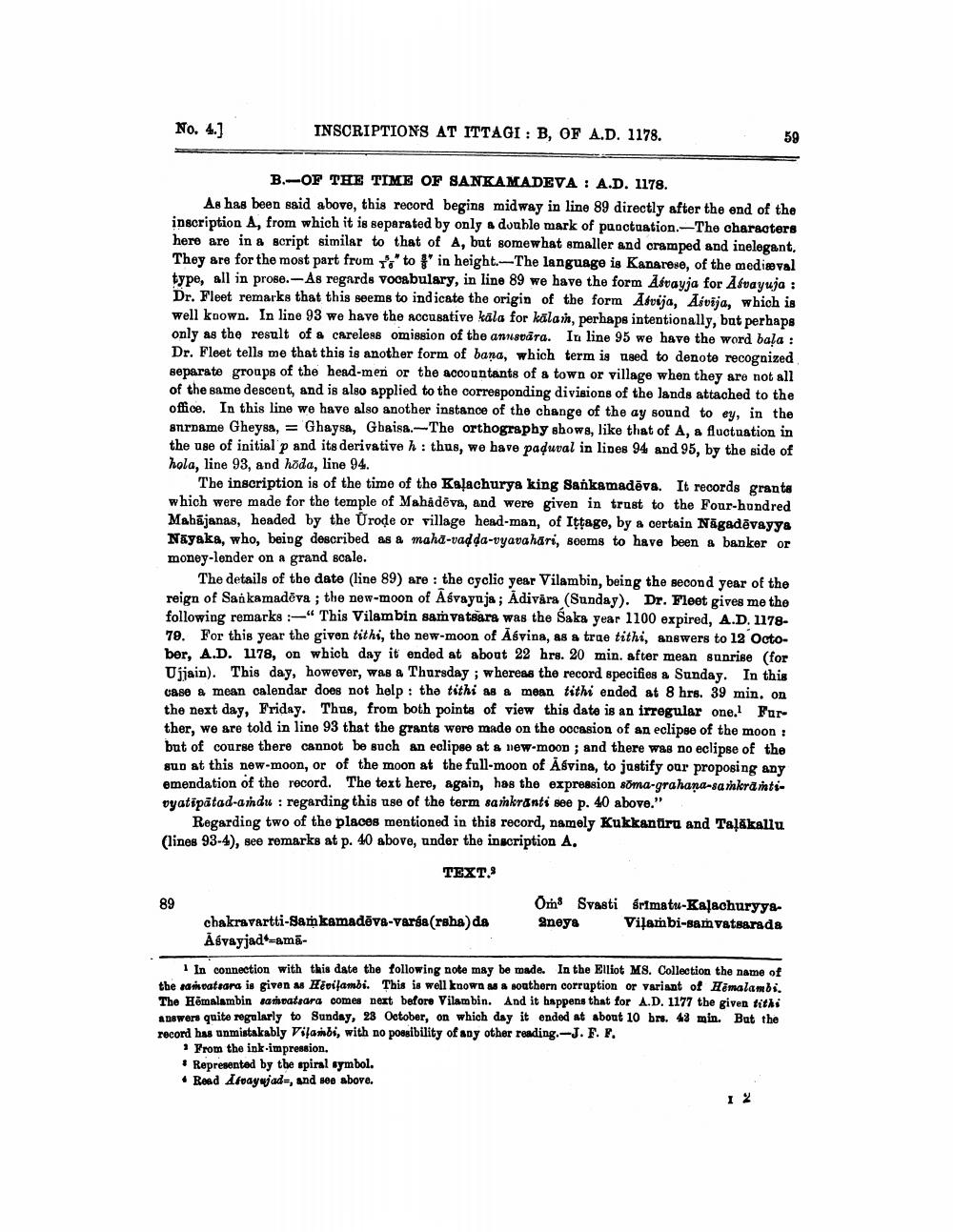________________
No. 4.]
INSCRIPTIONS AT ITTAGI: B, OF A.D. 1178.
B.-OF THE TIME OF SANKAMADEVA: A.D. 1178.
As has been said above, this record begins midway in line 89 directly after the end of the inscription A, from which it is separated by only a double mark of punctuation. The characters here are in a script similar to that of A, but somewhat smaller and cramped and inelegant. They are for the most part from " to " in height. The language is Kanarese, of the medieval type, all in prose.-As regards vocabulary, in line 89 we have the form Astayja for Asvayuja: Dr. Fleet remarks that this seems to indicate the origin of the form Asvija, Asvija, which is well known. In line 93 we have the accusative kala for kalam, perhaps intentionally, but perhaps only as the result of a careless omission of the anuseara. In line 95 we have the word bala: Dr. Fleet tells me that this is another form of bana, which term is used to denote recognized separate groups of the head-men or the accountants of a town or village when they are not all of the same descent, and is also applied to the corresponding divisions of the lands attached to the office. In this line we have also another instance of the change of the ay sound to ey, in the anrname Gheysa, Ghaysa, Ghaisa.-The orthography shows, like that of A, a fluctuation in the use of initial p and its derivative h: thus, we have paduval in lines 94 and 95, by the side of hola, line 93, and hōda, line 94.
The inscription is of the time of the Kalachurya king Sankamadeva. It records grants which were made for the temple of Mahadeva, and were given in trust to the Four-hundred Mahajanas, headed by the Urode or village head-man, of Iṭṭage, by a certain Nagadevayya Nayaka, who, being described as a maha-vadḍa-vyavahari, seems to have been a banker or money-lender on a grand scale.
The details of the date (line 89) are: the cyclic year Vilambin, being the second year of the reign of Sankamadeva ; the new-moon of Asvaynja; Adivara (Sunday). Dr. Fleet gives me the following remarks:-"This Vilambin samvatsara was the Saka year 1100 expired, A.D. 117879. For this year the given tithi, the new-moon of Asvina, as a true tithi, answers to 12 October, A.D. 1178, on which day it ended at about 22 hrs. 20 min. after mean sunrise (for Ujjain). This day, however, was a Thursday; whereas the record specifies a Sunday. In this case a mean calendar does not help the tithi as a mean tithi ended at 8 hrs. 39 min. on the next day, Friday. Thus, from both points of view this date is an irregular one. Further, we are told in line 93 that the grants were made on the occasion of an eclipse of the moon : but of course there cannot be such an eclipse at a new-moon; and there was no eclipse of the sun at this new-moon, or of the moon at the full-moon of Asvina, to justify our proposing any emendation of the record. The text here, again, has the expression soma-grahana-samkramtivyatipatad-amdu: regarding this use of the term samkranti see p. 40 above."
:
89
Regarding two of the places mentioned in this record, namely Kukkanuru and Taļākallu (lines 93-4), see remarks at p. 40 above, under the inscription A.
TEXT.'
chakravartti-Sam kamadeva-varsa (raha) da Asvayjad*=ama
59
Om Svasti Srimatu-Kalachuryya2neya Vilambi-samvatsarada
1 In connection with this date the following note may be made. In the Elliot MS. Collection the name of the samvatsara is given as Hevilambi. This is well known as a southern corruption or variant of Hemalambi. The Hemalambin samvatsara comes next before Vilambin. And it happens that for A.D. 1177 the given tithi answers quite regularly to Sunday, 23 October, on which day it ended at about 10 hrs. 43 min. But the record has unmistakably Vilambi, with no possibility of any other reading.-J. F. F.
From the ink-impression. Represented by the spiral symbol. Read Afvayajad=, and see above.
1 2




